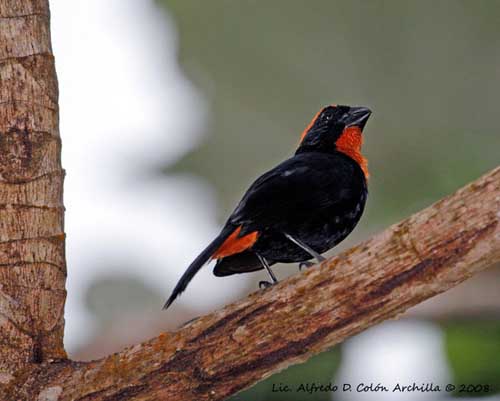
Fr: Sporophile de Porto Rico
All: Rotkopf-Gimpelfink
Esp Porto Rico: Comeñame de Puerto Rico
Esp: Semillero Puertorriqueño
Ita: Ciuffolotto di Portorico
Nd: Roodkapdikbekje
Sd: Puerto Ricofink
Photographer:
Alfredo Colón
Puerto Rico Wildlife
Text by Nicole Bouglouan
Sources:
HANDBOOK OF THE BIRDS OF THE WORLD Vol 16 by Josep del Hoyo- Andrew Elliot-David Christie – Lynx Edicions – ISBN: 9788496553781
BirdLife International (BirdLife International)
Neotropical Birds – Cornell Lab of Ornithology
Iowa State University - Digital Repository @ Iowa State University
Puerto Rican Bullfinch
Loxigilla portoricensis
Passeriformes Order – Thraupidae Family
INTRODUCTION:
The Puerto Rican Bullfinch is endemic to the archipelago of Puerto Rico. Included in the genus “loxigilla”, it was formerly classified in the family Emberizidae.
This species is commonly seen in thick forests and woodlands at all elevations.
DESCRIPTION OF THE BIRD:
Biometrics:
Length: 16-19 cm
Weight: M: 27-45g – F: 24-45g
The Puerto Rican Bullfinch adult male has black plumage except the rufous to orange-red crown, chin, throat, breast and undertail-coverts.
The heavy bill is blackish. The eyes are dark brown. Legs and feet are dusky.

The female is similar, but her plumage is duller black.
The juvenile has dark olive-green plumage overall, except the orange-rufous undertail-coverts.
SUBSPECIES AND RANGE:
There were two subspecies, but one of them is now extinct.
L.p. portoricensis (here described and displayed) is found on Puerto Rico
L.p. grandis is extinct, and was found in Lesser Antilles. This race was larger than nominate, with thicker bill. The rufous colour was darker and less extended on the throat.
HABITAT:
The Puerto Rican Bullfinch occurs in both montane and lowland evergreen forests, and in tropical deciduous forests. It also frequents secondary forests, dry coastal woodlands and sometimes mangroves.
This species can be seen from sea-level up to 1000 metres of elevation.

CALLS AND SONGS: SOUNDS BY XENO-CANTO
The Puerto Rican Bullfinch’s call is a tiny ‘tsuit” and a “check”.
The song is a series of several rising whistles followed by a sharp trill, a loud “coochi, coochi, choochi” and buzzy sounds.
It sings at any time of the day, hidden in the thick canopy foliage.
BEHAVIOUR IN THE WILD:
The Puerto Rican Bullfinch feeds primarily on seeds and fruits, and occasionally on shoots and nectar. It also takes insects and snails.
It forages mainly in low to medium understorey vegetation, but it also drops to the ground. In trees, it often forages on the outer branches. It feeds mainly in the morning and the late afternoon.

It forages alone or in pairs, and in family groups. The ripe fruits are held under the foot, and it pecks to eat pieces of pulp.
The Puerto Rican Bullfinch is shy and secretive, often heard before to be seen.
As a sedentary species, it maintains a territory all year round and is faithful to this site.
During the breeding season, the male displays to the females. It can be seen with dropped wings extended from the body sides, and then, fluttering them rapidly.

The Puerto Rican Bullfinch has undulating flight with strong wingbeats interspersed with glides. It often crosses clearings and roads with low, fast flight. It also flies from branch to branch when foraging in trees.
REPRODUCTION OF THIS SPECIES:
The breeding season occurs mainly between February and June.
The Puerto Rican Bullfinch builds a spherical structure with woven plants materials and sticks. The inner part is usually lined with pieces of bark. There is a side entrance, but the nest may also be domed or totally enclosed with side-opening.
It is placed in tree fork, on tree branch or in tree cavity, but also in shrub or clump of grass.
The female usually lays 3 dull greenish eggs with dark markings. From an observation, the female incubates during 14 days. At hatching, the chicks are naked during 3-4 days. Then, they have sparse down on head and back, while the flight-feathers start to grow 10 days later. They fledge 14-15 days after hatching.
There is little information, but from other observation in the wild, the female incubates alone, while the male sings in the surrounding.
Juveniles of the previous brood have been seen with nest materials and taking part in nest-building, but there is no more information about any additional help in nesting duties.

PROTECTION / THREATS / STATUS:
The Puerto Rican Bullfinch of nominate race is not globally threatened. This species is very common in forested areas and especially in montane forests.
The race “grandis” is not reported since 1920s, and now considered extinct.
However, the nominate race is suspected to be declining due to habitat destruction.
